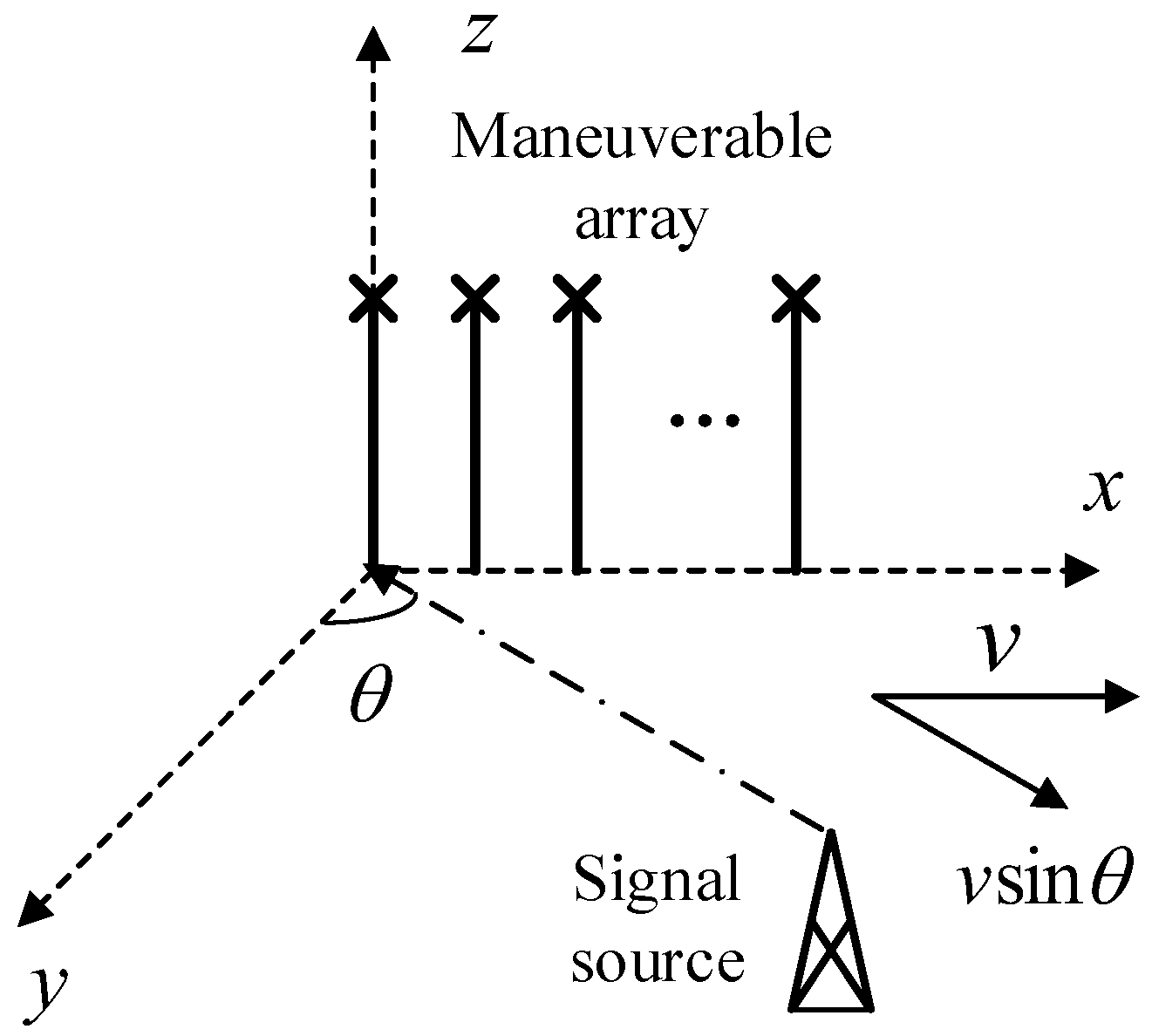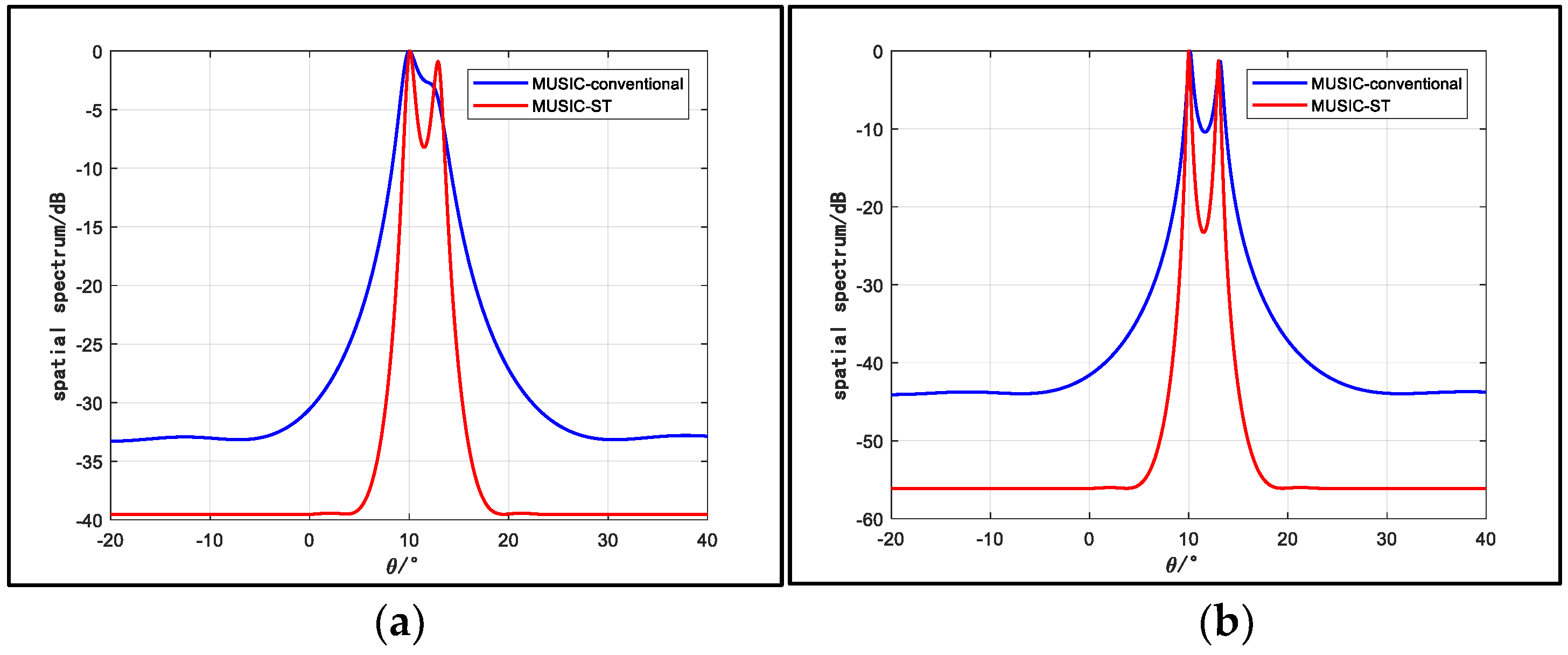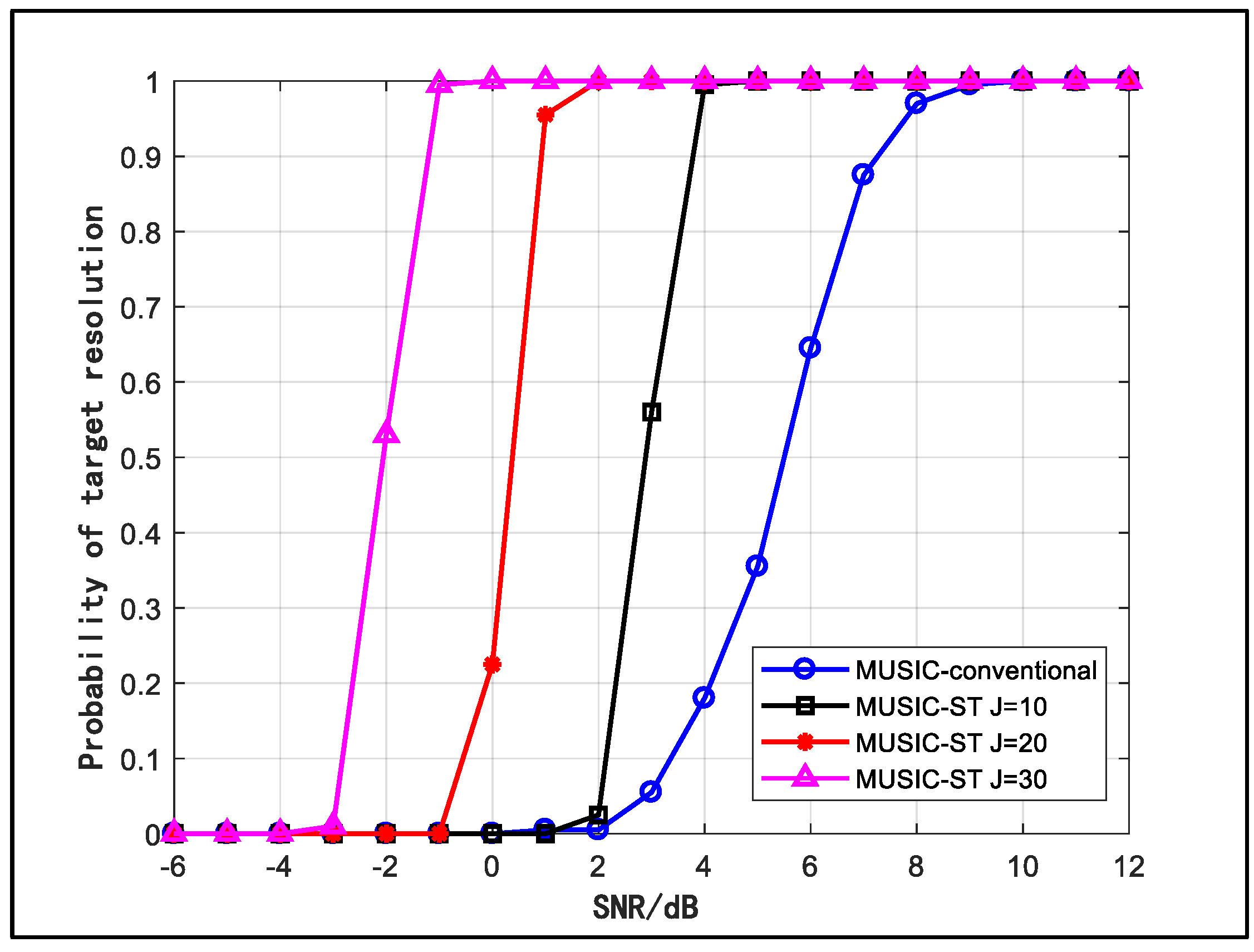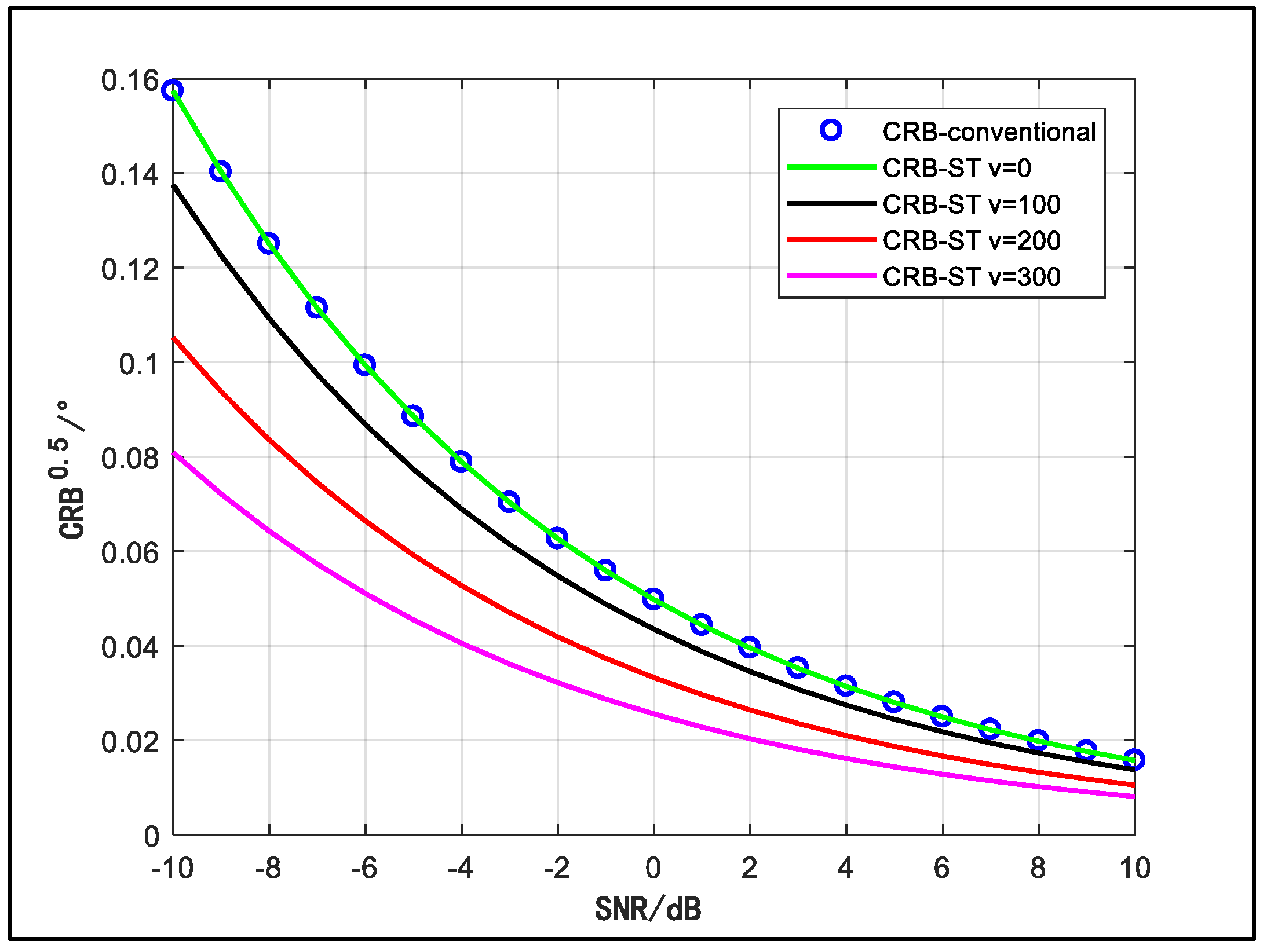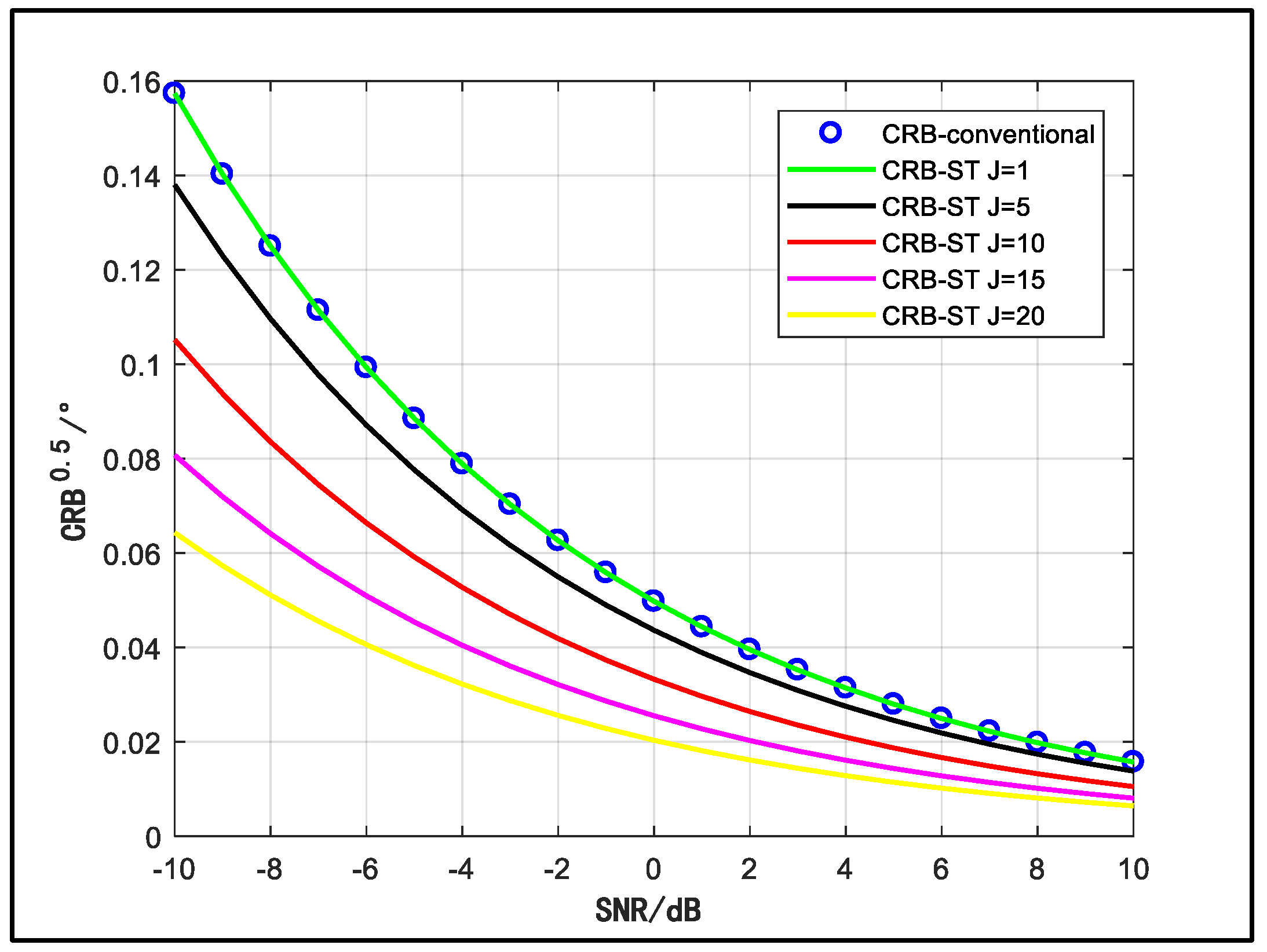1. Introduction
Direction of arrival (DOA) estimation is an important branch of array signal processing. The performance of DOA estimators mainly depends on the aperture of the array. In the modern electromagnetic environment, antenna arrays may be deployed on moving platforms (e.g., airplanes, satellites, ships) to enhance their maneuverability [
1]. However, apertures of those arrays are generally restricted by the size of platform they attached to, which could lead to degradation on DOA estimation performance if not of a suitable size [
2].
Various methods have been proposed to solve this problem, for instance, high order cumulant [
3], cyclostationarity [
4] and non-circularity [
5] of the signal were exploited to improve DOA performance. These techniques rely on temporal properties of the signal waveform, so they are only suitable for specific signals. Algorithms based on intelligent processing were also developed for DOA estimation. In [
6], a deep neural network (DNN) was designed and satisfactory DOA performance were observed. The above algorithms have their respective advantages, but they are not effective when array apertures are limited.
In other studies, some compressive sensing (CS)-based DOA estimation algorithms take the moving array condition into consideration. Reference [
7] formulated the DOA estimation problem as a Multiple Measurement Vectors (MMV) problem and solved it by minimizing a mixed Euclidean norm approximation. Liu [
8] also adopted Euclidean norm minimization approach to estimate the DOA, but divided the range of interest into low-resolution grids, which conspicuously reduced the computation complexity. Reference [
9] employed a second order core (SOC) programming method to solve the optimization problem. However, CS technique algorithms are mainly designed to deal with sample limitation problems. They cannot figure out the raised problem where a limited array aperture is available.
Alternatively, the synthetic aperture (SA) technique, which utilizes Doppler information to improve DOA performance, has received increasing attention in moving array systems. This technique was firstly used in cooperative scenarios for radar imaging [
10,
11] and then extended to non-cooperative acoustic processing [
12,
13,
14]. However, the applications of the SA technique in communication signal processing have not been addressed often. Unlike radar or sonar where the signal source is under the control of the receiver, communication signals have complicated modulation patterns and unknown data sequences, which generate unpredictable phase fluctuations in the signal Doppler information. Researchers then modified the SA technique and proposed space-time signal processing methods for the purpose of applying the SA technique to communication signals [
15]. These space-time processing methods mainly focus on the scenario where a static array detects a moving target [
16]. Reference [
17] analyzed the performance of such space-time signal models.
To the best of our knowledge, methods intended for communication signals with moving array have not received much attention. On the basis of the existing SA techniques, we propose a space-time array model for moving arrays in this paper. Its performance is thoroughly analyzed for comparison with a conventional array. First, the distinguished source number is derived under different conditions. Then we utilize the Euclidean norm to analyze the array spatial resolution enhancement. Finally, the Cramér-Rao bound (CRB) is computed in order to evaluate the estimation accuracy. The theoretical results are further discussed so as to cope with the parameter selection problem for space-time arrays. In contrast to conventional arrays, the proposed space-time array introduces Doppler information into the DOA estimation and manifests superior performance. Numeric simulations are also provided to demonstrate its effectiveness.
The paper is organized as follows:
Section 2 presents some assumptions and the space-time array model. In
Section 3, we evaluate the performances of space-time array through distinguishable source number, spatial resolution and CRB of such three aspects. The performance comparison and some theoretical conclusions are also involved in this section. In
Section 4, several numerical simulations are presented to verify the theoretical derivation. Finally,
Section 5 presents our conclusions and identifies future work.
2. Scenario Description and Space-Time Array Modeling
Assume that a uniform linear array is equipped on a moving platform. The array is composed of
sensors with an inter-element spacing
d (
d is equal to half the wavelength), and the platform moves along its baseline at a constant velocity
. The scenario is demonstrated in
Figure 1.
We assume that Q far-field plane waves impinge on the array from directions with frequencies centered at f0, which is known to the observer. c is the velocity of the electromagnetic wave. Because of movement of the array, a Doppler shift is generated and added to the carrier frequency.
Regarding the first sensor as a reference, we can express the observation signal of the
m-th sensor at time
t as:
where
is the Doppler shift,
is the signal waveform of the
q-th source with power
,
is zero-mean, spatially and temporally white noise with power
. In addition, the noise is assumed to be uncorrelated with signals, and signals are assumed to be uncorrelated.
Since
, the term
in Equation (1) is approximated to zero. Moreover, as
is known, we can down-convert the observation signal to obtain:
where
represents the observation signal after down-conversion.
From Equation (2), we can find that the time domain samples constitute a geometric sequence like a uniform linear array manifold, so we consider creating a manifold structure in the time domain which is similar to the space domain for obtaining the space-time array.
Supposing that samples are available, the total samples can be divided into equal time segments. Every segment has () samples. To ensure the coherence of signals in a segment, we assume that the duration of a segment is less than the coherence time of the signal. This assumption enables us to ignore the phase fluctuation generated by in the same segment.
Then in the
p-th segment, the observed signal of the
m-th sensor at the
j-th sample moment can be expressed as:
where
represents the sample interval. We can define
as the initial phase of the
p-th segment. Besides, the phase shift of every sample moment during the same segment can make up a vector as follows:
The vector
is similar to spatial manifold vector
, so we can recognize
as the temporal manifold vector and its dimension is
. Then supposing that
is the observation signal of the
m-th sensor in the
p-th segment, we can represent
as:
where
is the space-time input of the
q-th source.
is the space-time noise of the
m-th sensor. We define
and
as the power of space-time input and noise, respectively. From the structure of
and
, we can know that
and
. Utilizing the result of Equation (5), we can get an
-dimensional space-time array observation vector
, which can be written as:
where
is the spatial manifold vector.
is the space-time manifold vector.
is the space-time noise vector.
represents the Kronecker product.
To express Equation (6) in matrix form, we define
,
,
, then the signal model becomes:
where
is the Khatri-Rao product. The
-dimensional space-time manifold matrix is
.
The modified model transforms temporal samples into virtual sensors, which is equivalent to changing an sensors uniform linear array (ULA) into an sensors linear array (not always uniform).
3. Performance Analysis
This section presents the performance analysis of the space-time array. The comparison with a conventional array is implemented to demonstrate its advantages in the aspects of distinguishable source number, spatial resolution and CRB.
3.1. Distinguishable Number of Sources
The number of sources that an array can specify is mainly dependent on its sensor number and the rank of the source sample-correlation matrix. As the equivalent sensor number of a space-time array is enlarged, the distinguishable source number is supposed to increase. We provide a detailed analysis below.
Wax and Ziskind have deduced relevant conclusions in [
18]. Their work takes into account the case that signals are correlated and have strong universality. In this paper, we have assumed that signals are uncorrelated. Meanwhile, for simplicity, we suppose that the sample number is sufficient, thus the source sample-correlation matrix is full rank, whose rank is equal to the source number
. Then using the results from [
18], we can easily get that the maximum distinguishable source number of a conventional array is:
For space-time arrays, the condition is slightly more complicated. The maximum of
is in the range of the following condition [
19]:
We note that the distinguishable source number of he space-time array is increased, which coincides with our expectation. However, its maximum is not equal to the virtual sensor number MJ, but a range from to . This condition results from the selection of the sample interval Ts(1/ff). Equation (4) indicates that the equivalent element spacing of is . When , the elements of will overlap with those of , which causes that the virtual array has only distinct elements and leads to the least case. On the other hand, when the time domain array is a sparse ULA comprising elements with interelement spacing (i.e., ), the virtual array is a filled-element () ULA. This case leads to the result that the maximum number of sources that can be uniquely identified by a space-time array is times larger than that of a conventional array.
3.2. Spatial Resolution
Resolution is one of the important indexes for measuring the array performance. The spatial resolution of an array is closely correlated with the changing rate of the steering vector. To intuitively compare the resolution of different arrays, a scalar
can be defined to represent the resolving ability [
20]:
where
is the steering vector,
represents the Euclidean norm of a vector.
Here we suppose that
and
are the resolution of conventional array and space-time array, respectively. To avoid the presence of the cross terms, we set the centers of spatial and temporal steering vector to be the reference point. The final expressions are:
We can observe that
contains a term introduced by time domain information in the numerator while
does not contain it. Besides,
possesses
as the coefficient which is
times that of
, so the relationship between
and
is guaranteed to be:
Equation (13) indicates that the space-time array can improve the spatial resolution in the scenario assumed in this paper. Moreover, we can find that will increase when , or increases. Hence, longer duration of the time segment and higher velocity are beneficial to the resolution.
3.3. CRB
In this section, we derive the DOA estimation CRB of conventional and space-time array model. Then a comparison is provided to provide some in-depth conclusions about the performance.
The derivation of CRB generally relies on random signal (Gaussian) model or nonrandom (conditional) signal model. In this paper, we consider that the sources are nonrandom.
We define
as the CRB of the conventional array model. According to the work of [
21], the value of
is computed as:
in which
represents the Hadamard product.
is the source covariance matrix. The matrix
is defined as:
where
denotes the identity matrix and the subscript is its dimension.
The CRB of space-time array model can also be obtained in a similar way. From Equations (6) and (7), we know that the dimension of the space-time observation signal
is
, where
is the equivalent sensor number and
is the equivalent sample number. Designating
as the CRB of space-time array model, it can be given by:
where
is the covariance matrix of space-time input.
is similarly defined as
, that is:
To be convenient to make contrast between the CRB of two models,
and
can be further deduced to become:
In Equations (16) and (17), is the signal-to-noise ratio (SNR) of the q-th signal and its value is (equal to ).
It is worth noting that
contains a time domain information term in the denominator. To concisely make comparison between
and
, we take the single signal case as the example. Then the relationship between the CRB of the two array models can be expressed as:
Obviously, when and , the temporal array can bring array gain and yield , which demonstrates that the space-time array model can reduce the CRB. Meanwhile, the increase of , or can enlarge the temporal array gain and lead to lower CRB.
Remark 1. As concluded above, and are important factors impacting the performance. However, Equation (4) indicates that the coherent processing interval is . This duration is subject to the signal coherent time. Thus parameter and cannot increase infinitely and should be carefully selected based on signal temporal coherence.
Remark 3. The condition can lead to optimal distinguishable source number . Nonetheless, the increase of may decrease when the signal coherent time is unchanged, which makes the improvement of the distinguishable source number inconspicuous. Hence it is suggested to enlarge for multi-signal cases.
Remark 3. Expressions of resolution and CRB have similar forms. has a time domain information term in the numerator while has this term in the denominator. Therefore, from the perspective of expressions, enhancement results from the simultaneous employment of spatial and temporal information.
Remark 4. is mainly impacted by the temporal manifold vector dimension since it possesses as the coefficient rather than . Therefore, we can properly enlarge and decrease when we need higher spatial resolution, and this operation will not degrade the DOA estimation accuracy (CRB preserved).
4. Simulation
In this section, some computer simulations are presented to verify our deduction about space-time arrays and demonstrate its performance. In the figures of this section, the curves with postfix ‘conventional’ and ‘ST’ denote the performance curves of a conventional array and a space-time array, respectively. We consider a uniformly linear array with nine sensors. The array is equipped on an airplane and moves along its baseline at a constant velocity of 200 m/s.
First, we resort to the MUSIC algorithm to check the resolving ability of the space-time array (the specific operations of the algorithm can be seen in
Appendix C). Assume that two narrow-band signals are impinging on the array from angles of 10° and 13°, respectively. The carrier frequency is 300 MHz. The dimension of the temporal manifold vector is 20 (
= 20). The sample number is 1200 and the sample interval (
) after down-conversion is set to satisfy
.
Figure 2 displays the spatial spectrum of two arrays for different SNRs. In
Figure 2a, only the space-time array can distinguish the two sources. In
Figure 2b, when the SNR is high, the two arrays can both distinguish them.
To further demonstrate the spatial resolution enhancement, we plot the probability of the target resolution curves for different values of
in
Figure 3, where the input SNR changes from −6 dB to 12 dB and other conditions are maintained. From the figure, we can see that the space-time array has better source resolution capability than the conventional array especially in the low SNR region, and the result appears to achieve higher probability of target resolution with larger
. Hence, the array spatial resolution can be enhanced by involving more virtual antennas. The results in
Figure 2 and
Figure 3 indicate that the capability of resolving adjacent sources of a space-time array is much better than that of a conventional array.
Next, we verify the deduction about CRB.
Figure 4 and
Figure 5 show the contrast between the CRB of the conventional and space-time array model over SNR and sample number, respectively. In
Figure 4, we assume that a signal is impinging on the array from 15°. The signal carrier frequency, sample number, sample interval and platform moving velocity stay the same as the scenario in
Figure 2 and
Figure 3. The dimension of the temporal manifold vector is 10 (
= 10). The SNR changes from from −10 dB to 10 dB. In
Figure 5, we fix SNR at a constant value of 5 dB. The sample number changes from 200 to 1200. Other conditions are the same as
Figure 4. From the two figures, it can be observed that the CRB of the space-time array is obviously lower than that of the conventional array, which indicates that the space-time array can improve the estimation accuracy.
Figure 6 shows the CRB performance of the space-time array for different velocities. We set the same scenario as
Figure 4, and the signal carrier frequency, sample number and sample interval are also unchanged. The dimension of
is 10 (
= 10). We can observe that the CRB performance improved with the velocity gets larger. When the velocity reaches 300 m/s, the CRB can reach below 0.01° for high SNR. Besides, for low SNR, the improvement is more obvious.
Like
Figure 6, we depict five curves to represent different temporal manifold vector dimensions in
Figure 7. The velocity is 200 m/s and other conditions stay the same. It can be seen that the performance is better with more equivalent temporal array elements, but the improvement tendency becomes slower with enlarged
. Besides, we know that the complexity of the space-time array will extend when
increases, so it is important to make a compromise between complexity and performance for the selection of
.
In
Figure 6 and
Figure 7, specially, when
= 0 or
= 1, the performance curve is coincident with the curve of the conventional array. Under the condition that
= 0, i.e., the array is static, there is no Doppler shift in the signal time domain. The temporal manifold vector
, which does not contain DOA information. Therefore, although the dimension of the space-time manifold vector is enlarged, the available information is not increased so that the performance is not improved. On the other hand, for the case that the signal has relatively wide bandwidth, whose coherent time is short, the number of the samples in a time segment is limited. In the worst case (i.e.,
= 1), the dimension of the array steering vector is not extended, which means that the DOA information in time domain is not employed, so the performance curve also converges to the curve of the conventional array.
